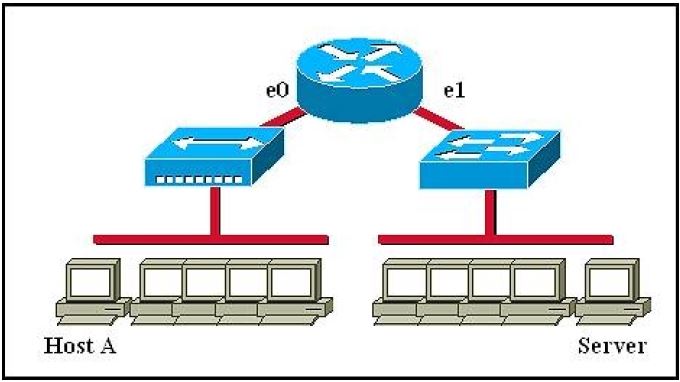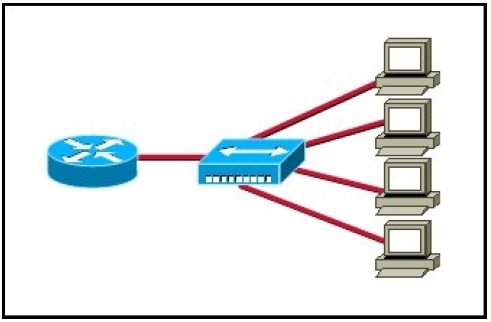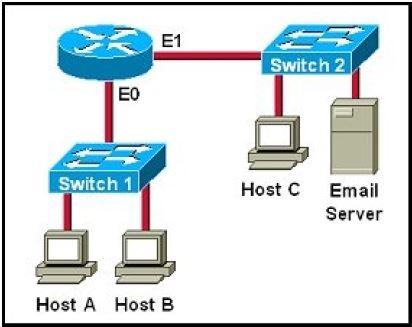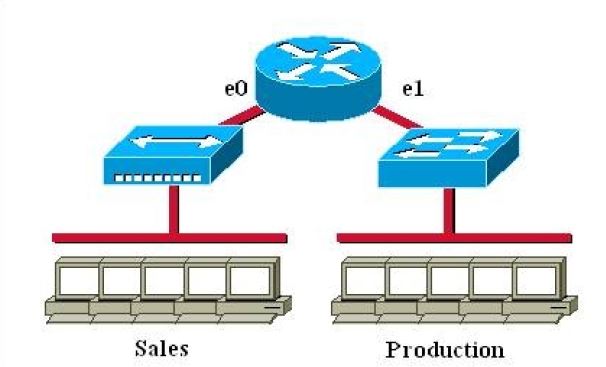Which of the following correctly describe steps in the OSI data encapsulation process? (Choose two.)
A. The transport layer divides a data stream into segments and may add reliability and flow control information.
B. The data link layer adds physical source and destination addresses and an FCS to the segment.
C. Packets are created when the network layer encapsulates a frame with source and destination host addresses and protocol-related control information.
D. Packets are created when the network layer adds Layer 3 addresses and control information to a segment.
E. The presentation layer translates bits into voltages for transmission across the physical link.
CISCO CCNA Exam – Q87
Refer to the graphic.

Host A is communicating with the server. What will be the source MAC address of the frames received by Host A from the server?
A. the MAC address of router interface e0
B. the MAC address of router interface e1
C. the MAC address of the server network interface
D. the MAC address of host A
CISCO CCNA Exam – Q86
Refer to the exhibit.

What two results would occur if the hub were to be replaced with a switch that is configured with one Ethernet VLAN? (Choose two.)
A. The number of collision domains would remain the same.
B. The number of collision domains would decrease.
C. The number of collision domains would increase.
D. The number of broadcast domains would remain the same.
E. The number of broadcast domains would decrease.
F. The number of broadcast domains would increase.
CISCO CCNA Exam – Q85
Which three statements accurately describe Layer 2 Ethernet switches? (Choose three.)
A. Spanning Tree Protocol allows switches to automatically share VLAN information.
B. Establishing VLANs increases the number of broadcast domains.
C. Switches that are configured with VLANs make forwarding decisions based on both Layer 2 and Layer 3 address information.
D. Microsegmentation decreases the number of collisions on the network.
E. In a properly functioning network with redundant switched paths, each switched segment will contain one root bridge with all its ports in the forwarding state. All other switches in that broadcast domain will have only one root port.
F. If a switch receives a frame for an unknown destination, it uses ARP to resolve the address.
CISCO CCNA Exam – Q84
Where does routing occur within the DoD TCP/IP reference model?
A. application
B. internet
C. network
D. transport
CISCO CCNA Exam – Q83
Refer to exhibit:

Which two destination addresses will be used by Host A to send data to Host C? (Choose two.)
A. the IP address of Switch 1
B. the MAC address of Switch 1
C. the IP address of Host C
D. the MAC address of Host C
E. the IP address of the router’s E0 interface
F. the MAC address of the router’s E0 interface
CISCO CCNA Exam – Q82
For what two purposes does the Ethernet protocol use physical addresses? (Choose two.)
A. to uniquely identify devices at Layer 2
B. to allow communication with devices on a different network
C. to differentiate a Layer 2 frame from a Layer 3 packet
D. to establish a priority system to determine which device gets to transmit first
E. to allow communication between different devices on the same network
F. to allow detection of a remote device when its physical address is unknown
CISCO CCNA Exam – Q81
Refer to the exhibit.

Based on the information given, which switch will be elected root bridge and why?
A. Switch A, because it has the lowest MAC address
B. Switch A, because it is the most centrally located switch
C. Switch B, because it has the highest MAC address
D. Switch C, because it is the most centrally located switch
E. Switch C, because it has the lowest priority
F. Switch D, because it has the highest priority
CISCO CCNA Exam – Q80
Which of the following statements describe the network shown in the graphic? (Choose two.)

A. There are two broadcast domains in the network.
B. There are four broadcast domains in the network.
C. There are six broadcast domains in the network.
D. There are four collision domains in the network.
E. There are five collision domains in the network.
F. There are seven collision domains in the network.
CISCO CCNA Exam – Q79
In an Ethernet network, under what two scenarios can devices transmit? (Choose two.)
A. when they receive a special token
B. when there is a carrier
C. when they detect no other devices are sending
D. when the medium is idle
E. when the server grants access
